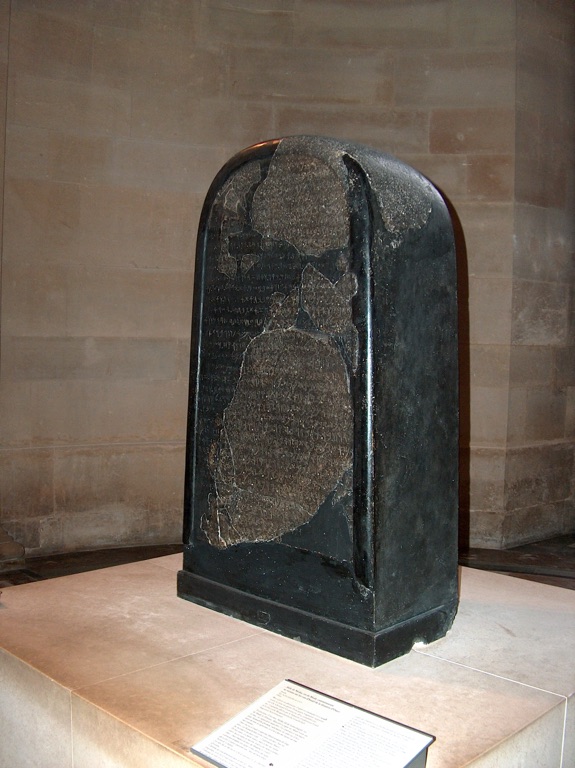The Mesha Stele, also known as the Moabite Stone, is a significant archaeological find from the ancient Near East. Discovered in 1868, it is an inscribed stone erected by King Mesha of Moab in the 9th century BCE. The stele boasts of Mesha’s victories over the Israelites and his building projects. It is particularly famous for its mention of the “House of David,” providing one of the few extrabiblical references to the Davidic dynasty. The artifact is a crucial source for the study of the Moabite language and the history of the region.
Get your dose of History via Email
Historical Background of The Mesha Stele
The Mesha Stele was unearthed in 1868 by Frederick Augustus Klein, an Anglican missionary. He found it in Dhiban, the ancient city of Dibon, in modern-day Jordan. The stele was created under the orders of King Mesha, who ruled Moab, a kingdom located in what is now Jordan. Mesha’s reign is thought to have been around the 9th century BCE.
After its discovery, the stele became a subject of conflict. Local villagers, fearing that the missionaries would take their treasure, lit a fire and poured cold water on the stone, causing it to shatter. Fortunately, a paper-mache impression had been made before the destruction, preserving its inscription. The fragments were eventually acquired by the Louvre Museum in Paris.
King Mesha, the creator of the stele, is also mentioned in the Hebrew Bible in the Book of Kings. He is known for rebelling against the Kingdom of Israel after the death of King Ahab. The stele provides a narrative from the Moabite perspective, celebrating Mesha’s liberation of Moabite lands from Israelite occupation and his subsequent building projects.
The site where the stele was found, Dhiban, was once a capital city of the Moabite kingdom. It later became inhabited by other civilizations, including the Nabateans and Romans. The city’s long history makes it a site of considerable historical importance.
The Mesha Stele is not only significant for its historical narrative but also for its linguistic value. It is one of the earliest known examples of the Moabite language, which is closely related to Hebrew. The stele’s text has provided scholars with insights into the language, culture, and political landscape of the region during the Iron Age.
About The Mesha Stele
The Mesha Stele is a black basalt monument, standing over one meter tall. Its text contains 34 lines written in the Moabite language, which is part of the Semitic family of languages. The stele’s inscription is the most extensive inscription ever recovered that is written in the Moabite script, a variant of the Phoenician alphabet.
The content of the stele is primarily a victory stele for King Mesha. It details his rebellion against the Kingdom of Israel following the death of King Ahab. The inscription describes the conquest of several towns, as well as the building and restoration of cities, roads, fortifications, and religious sanctuaries.
The stele’s construction is typical of the period, with the text carefully inscribed to commemorate the king’s achievements. The use of basalt as the material was a common choice for such monuments, as it is durable and able to withstand the elements, ensuring the message would endure for generations.
Architecturally, the stele does not boast elaborate decoration or imagery. Its significance lies in the text it bears. The straightforward, block-like shape of the stele focuses all attention on the inscribed message, which was the primary purpose of such monuments.
The Mesha Stele’s inscription provides a rare glimpse into the religious practices of the Moabites. It mentions the Moabite god Chemosh and credits him with victories over the Israelites. This religious aspect highlights the intertwining of political and religious life in the ancient Near East.
Theories and Interpretations
Since its discovery, the Mesha Stele has been the subject of various theories and interpretations. Its reference to the “House of David” has sparked debates among scholars regarding the historical existence of King David and the extent of his kingdom.
Some scholars have suggested that the stele’s mention of “Israel” could refer to a broader entity than the biblical Kingdom of Israel. This interpretation could imply a different understanding of the political landscape of the region during the 9th century BCE.
The precise translation of some parts of the text has been challenging. The Moabite language is not well-documented, leading to differing interpretations of certain phrases. This has resulted in ongoing scholarly discussions about the stele’s full meaning.
Dating the stele has been relatively straightforward, as the text refers to specific historical figures and events. However, the exact year of its creation remains uncertain. Scholars have used the biblical chronology and cross-referencing with other historical records to estimate the date.
The Mesha Stele has also been compared to other similar inscriptions from the region. These comparisons have helped to contextualize the stele within the broader history of the Near East and to understand the commonalities and differences in how ancient kingdoms documented their achievements.
At a glance
Country: Jordan
Civilization: Moabite Kingdom
Age: 9th century BCE
Conclusion and Sources
Reputable sources used in the creation of this article include:
- Wikipedia: https://en.wikipedia.org/wiki/Mesha_Stele

